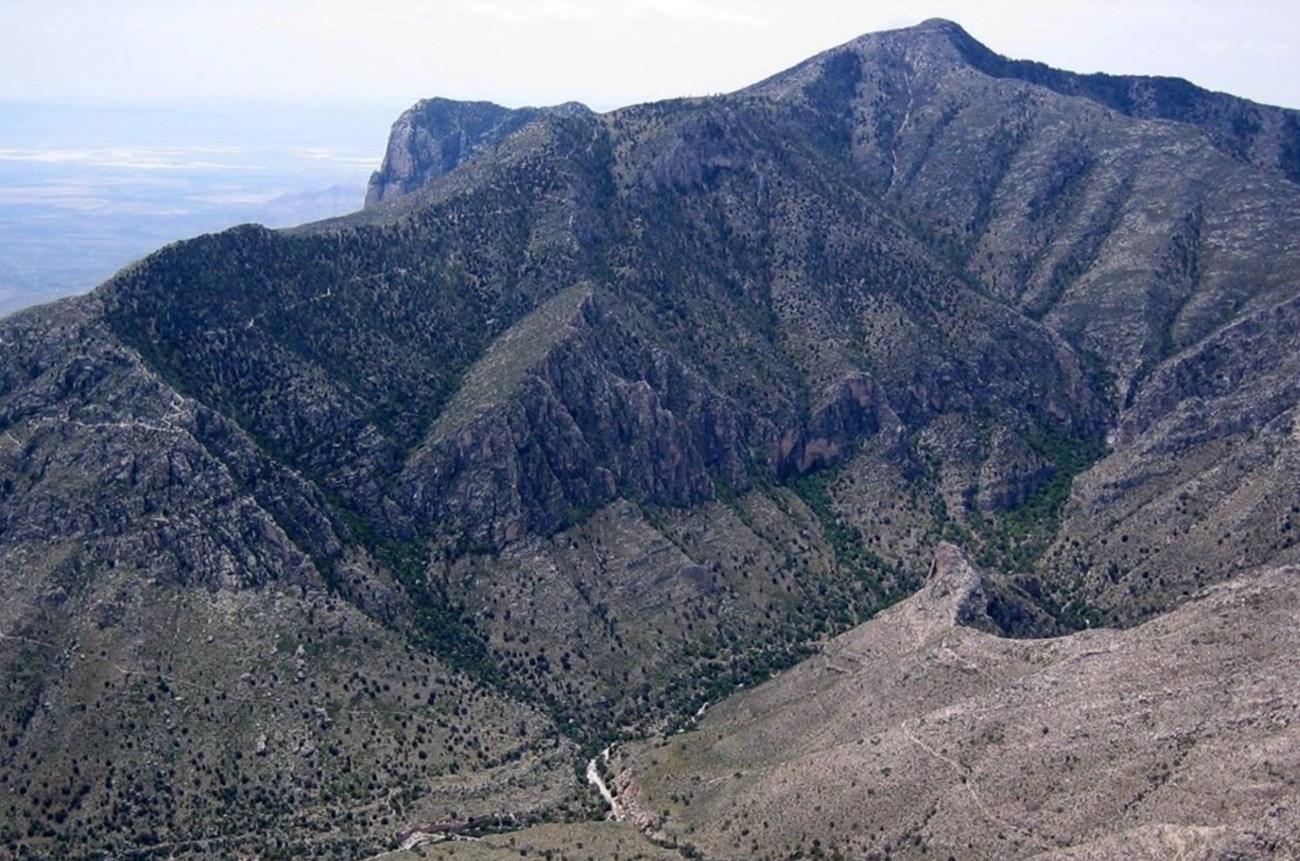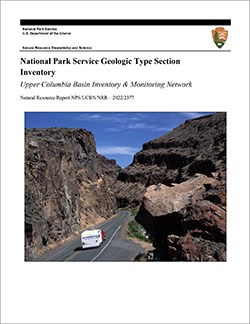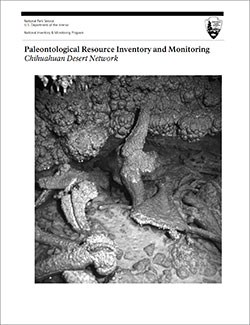
NPS photo.
Geology and Stratigraphy of the Chihuahuan Desert I&M Network Parks
The Chihuahuan Desert Inventory & Monitoring Network (CHDN) consists of seven national park units in the desert and mountain landscapes of southeastern New Mexico and west Texas. The Chihuahuan Desert is an expansive ecoregion covering nearly 647,500 km2 (250,000 mi2 ) of the southwestern United States and northern Mexico and represents one of the most biologically diverse deserts in the Western Hemisphere. The Chihuahuan Desert is geographically isolated and distinct ecologically from adjacent arid desert regions by two mountain ranges, the Sierra Madre Occidental to the west and the Sierra Madre Oriental to the east. Within the United States, the Chihuahuan Desert spans the Trans-Pecos region of Texas, along the Rio Grande River, into southern New Mexico.
The Chihuahuan Desert consists of a basin and range topography with broad desert valleys bordered by fault-block mountains. The topography forms closed basins which support playa lakes and dune field development. This ecoregion lies within the Pecos and Rio Grande drainage systems in the U.S. The Permian or Capitan reef system is represented in the Guadalupe and Glass Mountains in southern New Mexico and west Texas, supporting extensive cave and karst resources including Carlsbad Caverns National Park, which is a UNESCO World Heritage Site.
A Brief Geologic History
A few examples of events and Network resources in each geologic time period are highlighted below, from youngest to oldest.
An extensive Cenozoic history is preserved at Big Bend including rocks representing all Paleogene and Neogene epochs spanning from the Paleocene through the Pleistocene. Volcanic flows, talus slopes, pediments and graded plains extend from these mountain highlands. The Chisos Mountains are surrounded by huge fan-like aprons of sediments. Dikes and sills are exposed in and around the pediments. From oldest to youngest, the Cenozoic stratigraphy of Big Bend includes the Hannold Hill Formation (early Eocene), Canoe Formation (middle Eocene), Chisos Formation (middle Eocene– early Oligocene), South Rim Formation (early Oligocene), other Oligocene volcanics, Delaho Formation (late Oligocene–middle Miocene), Banta Shut-in Formation (late Miocene) and Pliocene–Pleistocene alluvium. Fort Davis is located in the Davis Mountains of west Texas and the geology is dominated by thick Cenozoic volcanics documented in three concordant volcanic units of late Eocene age (Everett 1967). White Sands, in the Tularosa Basin, has no exposures of lithified bedrock, instead being covered by a variety of unlithified sediments pertaining to the Quaternary Lake Otero system (KellerLynn 2012).
The Mesozoic geology of the Chihuahuan Desert Network is represented by Cretaceous units within Amistad, Big Bend, and Rio Grande Wild and Scenic River. The Cretaceous geology exposed within Amistad includes the Salmon Peak Limestone, Devils River Limestone, Del Rio Clay, Buda Limestone, and the Boquillas Formation. The grand cliffs that bound the Pecos River in the vicinity of Amistad are composed of Lower Cretaceous Devils River Limestone which represents some of the most complete exposures of Lower Cretaceous rock in North America (Kerans et al. 1995). Big Bend’s Mesozoic section is dominated by marine and terrestrial deposits from the Cretaceous. The thick Cretaceous sequence includes the terminal Cretaceous–Paleogene transition. The Cretaceous sequence in stratigraphic order includes: Glen Rose Limestone, Telephone Canyon Formation, Del Carmen Limestone, Sue Peaks Formation, Santa Elena Limestone, Devils River Limestone, Del Rio Clay, Buda Limestone, Boquillas Formation, Pen Formation, Aguja Formation, Javelina Formation, and Black Peaks Formation. Most of this sequence, from the Glen Rose Limestone to the Pen Formation, is also exposed within Rio Grande Wild and Scenic River.
The Paleozoic geology of the Chihuahuan Desert Network is represented at Big Bend, Carlsbad Caverns, and Guadalupe Mountains. Big Bend preserves a series of Paleozoic units which range from Ordovician to Early Pennsylvanian in age. During the Paleozoic the Big Bend area was situated within a northeasterly trending trough called the Ouachita Trough. The trough was submerged by marine seas and was a depositional center for continental sediments. Maxwell et al. (1967) refers to the Paleozoic sequences at Persimmon Gap as undifferentiated limestones, chert, novaculite, and shale from the Maravillas, Caballos, and Tesnus formations. The Tesnus Formation is Late Mississippian to Early Pennsylvanian in age with marine and non-marine units (Fan and Shaw 1956; Noble 1992). The lower unit of the Tesnus Formation consists of massive and interbedded marine sandstone turbidites and siliceous shales. The upper unit is predominantly non-marine and consists of fine-grained clastic sediments.
Permian strata are well-exposed at Guadalupe Mountains and Carlsbad Caverns in the Guadalupe Mountains of west Texas and southern New Mexico. A large normal fault defines the western flank of the Guadalupe Mountains, while the eastern edge is marked by the Capitan Reef escarpment. The reef escarpment preserves the Permian depositional profile of the Delaware Basin. The Capitan Reef is exposed in both Guadalupe Mountains and Carlsbad Caverns. At Guadalupe Mountains the reef consists of an uplifted block forming a prominent mountain range. At Carlsbad Caverns the reef is exposed in the same uplifted block but is at lower elevation due to a regional dip.
Three areas in Guadalupe Mountains have been designated by the International Union of Geological Sciences as Global Stratotype Sections for the middle Permian Guadalupian Series of the geologic time scale along with their component Roadian, Wordian, and Capitanian Stages (Henderson et al. 2012). The middle Permian is known worldwide as the Guadalupian Series.
The middle Permian Artesia Group (Tansill, Yates, Seven Rivers, Queen and Grayburg formations) and the Capitan Limestone are the primary geologic units exposed in both Carlsbad Caverns and Guadalupe Mountains. Older units representing the early and middle Permian are mapped at Guadalupe Mountains and include the Bone Spring Limestone, Victorio Peak Formation, Cutoff Formation, Brushy Canyon Formation, Cherry Canyon Formation, Goat Seep Dolomite, and Bell Canyon Formation.
The Chihuahuan Desert Network parks do not include any exposed or mapped Precambrian rocks within the park boundaries.
Geology & Soils—Chihuahuan Desert Network Parks
Type Sections—Chihuahuan Desert Network

The geologic history above is excerpted from a report titled, "National Park Service geologic type section inventory: Chihuahuan Desert Inventory & Monitoring Network". Type sections are essential reference locations for the geoscientists who study geologic history and paleontology. A summary of the type sections in each park can be found at the links below.
-
Amistad National Recreation Area, Texas (no designated stratotypes identified)
-
Big Bend National Park, Texas (contains 31 identified stratotypes)
-
Carlsbad Caverns National Park, New Mexico (no designated stratotypes identified)
-
Fort Davis National Historic Site, Texas (no designated stratotypes identified)
-
Guadalupe Mountains National Park, Texas (contains 21 identified stratotypes)
-
Rio Grande Wild and Scenic River, Texas (no designated stratotypes identified)
-
White Sands National Park, New Mexico (no designated stratotypes identified)
The full Network report is available in digital format from:
Please cite this publication as:
-
Henderson T, Santucci VL, Connors T, Tweet JS. 2021. National Park Service geologic type section inventory: Chihuahuan Desert Inventory & Monitoring Network. Natural Resource Report. NPS/CHDN/NRR—2021/2249. National Park Service. Fort Collins, Colorado.
NPS Stratotype Inventory
Fossil Resources—Chihuahuan Desert Network

Between 2002 and 2011, network-based paleontological resource inventories were completed for all the 32 I&M networks, and six of the earliest were completely updated between 2012 and 2016. The report linked below summarizes the paleontological resources of all park units in the Chihuahuan Desert Inventory & Monitoring Network (CHDN). The report provides geologic background and paleontological resource data for each park to support management operations, planning, and science-based decision making as required by NPS management policies and the Paleontological Resources Preservation Act (2009).
The full report is available in digital format from
Please cite this publication as:
-
Santucci, V.L., J.P. Kenworthy, and C.C. Visaggi, 2007. Paleontological Resource Inventory and Monitoring, Chihuahuan Desert Network. National Park Service TIC# D-500, 105 pages.
Geodiversity Atlas pages—by Inventory & Monitoring Network
Arctic Network Index
Central Alaska Network Index
Chihuahuan Desert Network Index
Cumberland Piedmont Network Index
Eastern Rivers and Mountains Network Index
Great Lakes Network Index
Greater Yellowstone Network Index
Gulf Coast Network Index
Heartland Network Index
Klamath Network Index
Mediterranean Coast Network Index
Mid-Atlantic Network Index
Mojave Desert Network Index
National Capital Network Index
North Coast and Cascades Network Index
Northeast Coastal and Barrier Network Index
Northeast Temperate Network Index
Northern Colorado Plateau Network Index
Northern Great Plains Network Index
Pacific Islands Network Index
Rocky Mountain Network Index
San Francisco Bay Area Network Index
Sierra Nevada Network Index
Sonoran Desert Network Index
South Florida/Caribbean Network Index
Southeast Alaska Network Index
Southeast Coast Network Index
Southern Colorado Plateau Network Index
Southern Plains Network Index
Southwest Alaska Network Index
Upper Columbia Basin Network Index
Geodiversity Atlas pages—by State, U.S. Commonwealth, and Territories
Alabama | Alaska | Arizona | Arkansas | California | Colorado | Connecticut | District of Columbia | Delaware | Florida | Georgia | Hawaii | Idaho | Illinois | Indiana | Iowa | Kansas | Kentucky | Louisiana | Maine | Maryland | Massachusetts | Michigan | Minnesota | Mississippi | Missouri | Montana | Nebraska | Nevada | New Hampshire | New Jersey | New Mexico | New York | North Carolina | North Dakota | Ohio | Oklahoma | Oregon | Pennsylvania | Rhode Island | South Carolina | South Dakota | Tennessee | Texas | Utah | Vermont | Virginia | Washington | West Virginia | Wisconsin | Wyoming
U.S. Commonwealth and Territories
Region 2: South Atlantic-Gulf (Includes Puerto Rico and the U.S. Virgin Islands)
Region 3: Great Lakes
Region 4: Mississippi Basin
Region 5: Missouri Basin
Region 6: Arkansas-Rio Grande-Texas-Gulf
Region 7: Upper Colorado Basin
Region 8: Lower Colorado Basin
Region 9: Columbia-Pacific Northwest
Region 10: California-Great Basin
Region 11: Alaska
Region 12: Pacific Islands (American Samoa, Hawaii. Guam, Commonwealth of the Northern Mariana Islands)
Last updated: February 21, 2025
